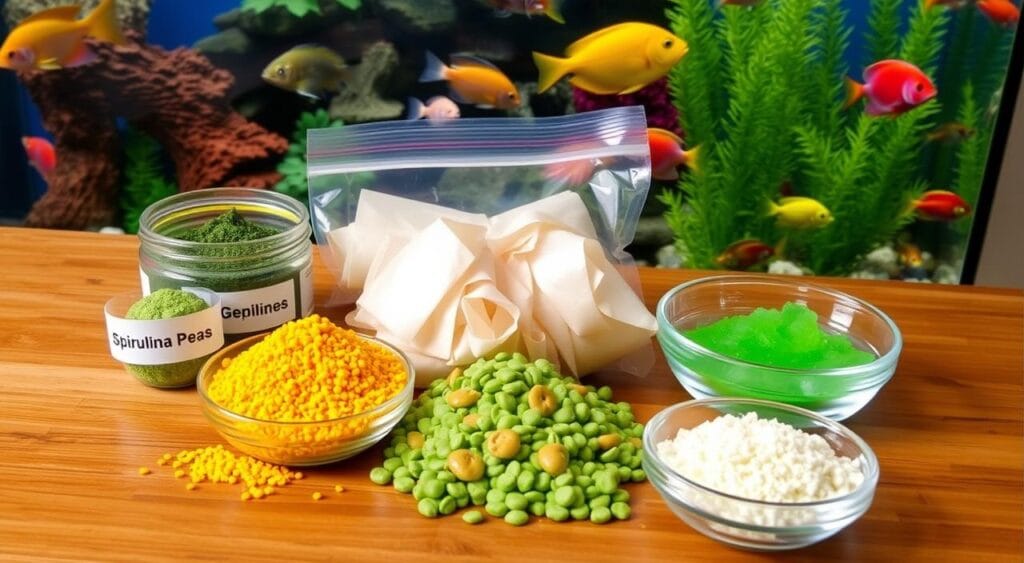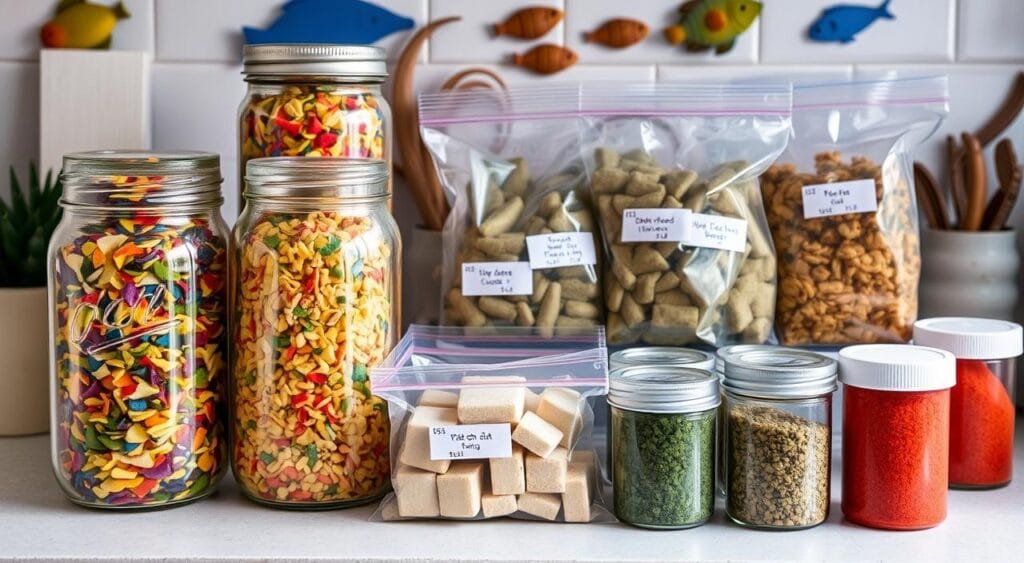Table of Contents
Fish Food Recipes As a fish owner, you want the best for your aquatic pets. A balanced diet is essential for their well-being and happiness. Making your own fish food ensures they get the nutrients they need.
These easy recipes let you tailor meals to your fish’s needs. You can choose from simple veggie dishes to protein-rich pellets.

Homemade fish food saves money and is better for the environment. It lets you avoid preservatives and use fresh ingredients. With a bit of practice, you can make healthy food for your fish.
Key Takeaways
- Making your own fish food at home can be a cost-effective and environmentally friendly way to feed your fish.
- A healthy fish food recipe can make all the difference in keeping your fish happy and thriving.
- Homemade fish food allows you to control the ingredients and quality of the food.
- Easy fish food recipes can be made with fresh ingredients and without preservatives.
- Creating a balanced and nutritious diet for your fish can help them stay healthy and thrive.
- With a little practice and patience, you can become an expert in making your own fish food.
- Using easy fish food recipes can help you provide your fish with the nutrients they need to stay healthy and happy.
Understanding the Benefits of Homemade Fish Food
Making fish food at home is easy and healthy for your aquatic pets. You can customize it for goldfish and pond fish. This ensures they get the nutrients they need to stay healthy.
Homemade fish food is also a cost-effective option. You can save money by avoiding commercial fish food. Plus, you control the ingredients and quality, which is key for your fish’s health.
Cost-Effective Feeding Solutions
- Reduced waste: homemade fish food can be made in small batches, reducing the amount of waste generated by commercial fish food packaging.
- Customized nutrition: by creating your own fish food list, you can tailor the ingredients to meet the specific nutritional needs of your fish.
Control Over Ingredients and Quality
When you make your own fish food, you have complete control over the ingredients and quality. This ensures that your fish receive the nutrients they need to stay healthy and thrive.
Environmental Benefits of DIY Fish Food
Homemade fish food also has environmental benefits. It reduces the carbon footprint of commercial fish food production and minimizes waste.
Essential Equipment and Ingredients for Fish Food Making
To make fish food at home, you’ll need basic tools and ingredients. A simple recipe can be made with a food processor, freezer, and common items like veggies, proteins, and grains. It’s key to use fresh, high-quality ingredients for the best nutrition.
Some important ingredients include:
- Vegetables like peas, carrots, and spinach
- Proteins like fish meal, shrimp meal, or soybean meal
- Grains like wheat, oats, or corn
You can also add supplements like vitamins and minerals to boost the food’s nutritional value.
Making fish food is easy in a few steps. First, grind the ingredients into a fine powder with a food processor. Then, mix the powder with water to get a dough-like texture. Finally, shape the dough into pellets or flakes. A simple recipe can guide you through this process.
By following a simple recipe and using the right tools and ingredients, you can make a healthy diet for your fish. Preparing fish food at home is both enjoyable and fulfilling. It also saves money on commercial food. With practice, you can make a tasty, easy fish food recipe that your fish will enjoy.
| Ingredient | Quantity | Purpose |
|---|---|---|
| Peas | 1 cup | Protein source |
| Carrots | 1/2 cup | Vitamin source |
| Fish meal | 1/2 cup | Protein source |
Seven Simple Fish Food Recipe Options for Your Aquatic Pets
As a responsible aquarium owner, you want to give your fish the best nutrition. A natural fish food recipe is a great way to do this. We’ll look at seven easy fish food recipes you can make at home, including a best fish food recipe for your aquarium.
These recipes range from a basic vegetable-based food to a protein-rich pellet. There are also recipes for goldfish, tropical fish, pond fish, saltwater fish, and herbivorous fish. Making your own homemade saltwater fish food or fish food recipe for aquarium lets you control the ingredients. This ensures your fish get the best nutrition.
- Basic Vegetable-Based Fish Food Recipe
- Protein-Rich Pellet Recipe
- Goldfish Special Blend
- Tropical Fish Flake Mix
- Pond Fish Food Formula
- Saltwater Fish Food Blend
- Herbivorous Fish Food Mix
By following these simple recipes, you can make a fish food recipe tailored to your fish’s needs. This provides them with the nutrients they need to thrive.
| Recipe | Ingredients | Instructions |
|---|---|---|
| Basic Vegetable-Based Fish Food Recipe | Vegetables, such as peas and carrots | Mix ingredients together and serve |
| Protein-Rich Pellet Recipe | Protein sources, such as fish meal and shrimp | Mix ingredients together and form into pellets |
Storage and Preservation Methods for Homemade Fish Food
Learning to make fish food flakes means you must think about how to keep it fresh. A good fish meal or feed recipe can spoil if not stored right. Use airtight containers to keep your homemade fish food fresh for longer.
Freeze-drying is another way to keep nutrients and flavor in. Vacuum-sealed bags or containers also work well to keep out moisture and air. Always label and date your containers so you use the oldest food first. This ensures your fish always eat the freshest, most nutritious food.
Here are some tips for storing and preserving your homemade fish food:
- Keep the food in a cool, dry location to avoid spoilage.
- Use airtight containers or vacuum-sealed bags to keep the food fresh.
- Label and date the containers to ensure you use the oldest food first.
- Freeze-dry the food to preserve it for a longer period.
By following these tips, your homemade fish food will stay fresh and nutritious. Whether it’s a simple meal or a complex feed, proper storage and preservation are key. This keeps the food quality high for your fish.

Common Mistakes to Avoid When Making Fish Food at Home
When making diy fish food, it’s key to know common mistakes. These can lower the food’s quality and nutrients. Make sure your easy fish food recipe is balanced and has all the nutrients your fish need.
To avoid mistakes, learn about your fish’s nutritional needs. A good healthy fish food recipe should have protein, veggies, and other key nutrients. Here are some common mistakes to steer clear of:
- Using low-quality ingredients that can harm your fish
- Not storing the food properly, leading to spoilage and contamination
- Overfeeding or underfeeding your fish may lead to various health issues.
By watching out for these mistakes, you can make a nutritious healthy fish food recipe. Always put your fish’s health first when making diy fish food at home.
Here is a simple table to help you get started with creating your own easy fish food recipe:
| Ingredient | Quantity | Nutritional Value |
|---|---|---|
| Fish meal | 1 cup | High protein content |
| Vegetables | 1/2 cup | Rich in fiber and vitamins |
| Supplements | 1 tablespoon | Essential vitamins and minerals |
By following these guidelines and avoiding common mistakes, you can create a delicious and nutritious diy fish food recipe that your fish will love.
Conclusion: Nurturing Your Fish with Homemade Care
By following the simple recipes in this guide, you can give your fish the food they need to thrive. Making your own fish food lets you choose the ingredients, ensuring a balanced diet for your fish. This method is also good for your wallet and the environment, reducing waste and protecting your aquarium or pond’s ecosystem.
Try out different recipes to find the one your fish enjoy the most. With a bit of creativity, you can make tasty homemade meals for your fish. Enjoy the process of caring for your aquatic friends with love and attention.
FAQ
What are the advantages of preparing homemade fish food?
Preparing your own fish food at home offers numerous benefits. It’s cheaper, lets you control what goes into it, and is better for the environment. You save money, ensure your fish get the nutrients they need, and cut down on waste.
What equipment and ingredients are required to make fish food at home?
To make fish food at home, you’ll need a food processor, airtight containers, and a freezer. You’ll also need vegetables, proteins, and grains. These ingredients help create balanced, nutritious meals for your fish.
What are some simple fish food recipe options I can try?
This guide offers seven easy fish food recipes. You’ll find a basic vegetable recipe, a protein-rich pellet, and more. These recipes cater to different types of fish, including goldfish and saltwater fish. Try them out to find the best one for your fish.
How should I store and preserve my homemade fish food?
Storing and preserving homemade fish food right is key. Use airtight containers and consider freeze-drying. Label and date the food to ensure you use the oldest first.
What common mistakes should you avoid when preparing homemade fish food?
Common mistakes include getting the ingredient balance wrong, storing it poorly, and feeding too much. Make sure your fish food is balanced, stored correctly, and fed in the right amounts. This will keep your fish healthy.

